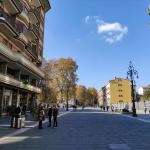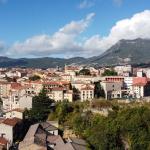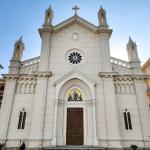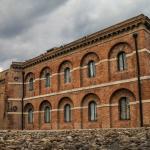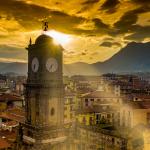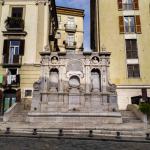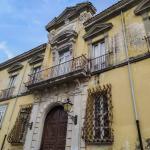Avellino is the capital of the province in Campania with the same name. It's a city with 53,640 inhabitants, located 348 metres above sea level. The territory extends for 30.55 sq km and the adjoining municipalities are: Aiello del Sabato, Atripalda, Capriglia Irpina, Contrada, Grottolella, Manocalzati, Mercogliano, Monteforte Irpino, Montefredane, Ospedaletto d'Alpinolo and Summonte. It's crossed by the river Sabato and by the stream Fenestrelle.
The etymology of the name seems to derive from the Latin "abellana", i.e. "hazelnut", a typical product of the territory rich in hazelnut groves. The inhabitants are called Avellinesi, and the patron saints are Saint Modestinus, Saint Florentinus and Saint Flavianus.
PLACES OF INTEREST
- Bourbon Prison - Charming architectural complex, dating back to the 19th century and used as a prison until 1987; today it houses an important part of the collection of the Irpino Museum and the State Archives
- Duomo - Cathedral of great architectural and historical importance, located in the heart of the historic centre, dedicated to Our Lady of the Assumption and Saints Modestinus, Florentinus and Flavianus; its crypt, in Romanesque style, is particularly evocative
- Clock Tower - Symbol of the city, this 36-metre-high Baroque monument towers over the historic centre
- Irpino Museum - Founded thanks to a donation by the lawyer Giuseppe Zigarelli, it's the city's main museum, the historical and archaeological emblem of Irpinia
- Civic Museum of Villa Amendola - A fine building embracing three centuries of history (the 18th, 19th and 20th centuries), handing down the precious testimony of an ancient private residence and preserving its splendid Botanic Garden
- Casino del Principe - Built at the behest of Prince Camillo Caracciolo, this historic building dates back to the 16th century and was an ideal place for hunting and entertainment at the time
- Theatre Carlo Gesualdo - Avellino's main theatre, inaugurated in 2002 with the presence of the President of the Republic; among the newly built theatres, it is one of the best in Italy for acoustics
- Bellerofonte Fountain - Commonly known as the "Fountain of the Tre Cannuoli" (Three Spouts), this Baroque work by Bergamo sculptor Cosimo Fanzago was created in the second half of the 17th century
- Caracciolo Palace - Headquarters of the provincial administration, a splendid historical building located in Piazza della Libertà, built between 1708 and 1713 at the behest of the Caracciolo family
- De Conciliis Palace - A lovely building dating back to the end of the 18th century, built by the De Conciliis family, it is famous for having hosted the French novelist Victor Hugo in 1808, hence the name "Hugo Palace"
- Church of the Santissimo Rosario (Most Holy Rosary) - Beautiful church located on Corso Vittorio Emanuele II, recently restored
- Municipal villa - Ancient Botanical Garden in Corso Vittorio Emanuele II, dating from the early 19th century
- Toll House - A masterpiece by Cosimo Fanzago in the Avellino of the Caracciolo princes, with the function of a "commodity exchange" in which the prices of grain were established, currently propped up
- Church and Convent of Santa Maria delle Grazie (Holy Mary of Graces) - A religious complex dating back to the late 16th century, it dominates one of the most evocative settings in the north-east of the city
- Church of San Francesco Saverio (Saint Francis Xavier) - Dating back to the 18th century, it is also known as "Church of Saint Rita", because of the procession held there every year.
- Green areas - Antonio Manganelli Park, Giovanni Palatucci Urban Park, Viale Italia
- Other churches - Church of San Biagio (Saint Blaise) , Church of Santa Maria del Rifugio (Our Lady of Refuge) or Saint Anne, Church of Santa Maria di Costantinopoli (Our Lady of Constantinople), Church of Saint Francis (in Borgo Ferrovia), Church and Conservatory of the Oblates, Church of San Generoso, Church of the SS. Trinità dei Poveri (Holy Trinity and the Poor), Redemptorist Church and College, Complex of San Giovanni Battista (Saint John the Baptist), Church of Cuore Immacolato della Beata Vergine Maria (Immaculate Heart of the Blessed Virgin Mary), Church of Santa Maria Assunta in Cielo (Saint Mary Assumed into Heaven)
- Other places of interest - Ruins of the Lombard Castle, Lombard tunnels, Obelisk of Charles II of Habsburg, Mural of Peace, Mural of the artist Millo at the railway station, Sculptures "Germoglio" (Piazzetta Perugini) and "Ali dell'Anima" (Piazza della Libertà), Curia Vescovile (Bishop's Curia)
EVENTS
- Palio della Botte - Historical competition held in August between the seven districts of the city of Avellino
- Procession of Our Lady of Sorrows - Held annually in the town since the beginning of the 16th century on Good Friday.
- Laceno d'Oro - Neorealist Film Festival, born in 1959 thanks to Pier Paolo Pasolini and Camillo Marino, it's one of the most historical and important events dedicated to the "cinema del reale" in Italy
- Procession of Saint Rita - Celebrations in honour of Saint Rita of Cascia, with a town procession held annually since 1937
- Procession of Our Lady of the Assumption - A religious event that has been held every year since the beginning of the 18th century on Ferragosto (midsummer holiday).
- Sportdays - Important sporting event scheduled in June
- Ferragosto Avellinese - Typical summer programme of cultural, musical and gastronomic events
- Christmas Markets - Food and wine event, with stands and markets along Corso Vittorio Emanuele II, scheduled for the Christmas season
- Avellino Carnival - Carnival celebrations, with a parade of masks from all over the province and the Zeza di Belizzi Irpino, on the occasion of Shrove Tuesday
TYPICAL FOOD AND PRODUCTS
- Cicci PAT - Traditionally known as 'Cicci di Santa Lucia', this is a mixed soup of locally produced cereals and legumes, seasoned with garlic and peppers
- Pizza chiena PAT - Exquisite variation of home-made bread, stuffed with spicy sausage and pieces of lard and scamorza cheese
- Fusilli al ferretto - Fresh pasta with meat sauce
- Pizza con l'erba - Typical avellinese pizza with ricotta cheese, escarole and granone cheese
- Crespelle, struffoli and calzoncelli - Typical sweets of the Avellino tradition
- Fiano di Avellino DOCG - One of the finest white wines in Italy and on the international market
- Hazelnut - The Avellana/Irpina hazelnut (Nux avellana), with its strong historical, cultural and socio-economic link to its geographical area of origin, is a gastronomic excellence with a rich assortment of varieties: Mortarella, San Giovanni, with elongated fruit (more than two thirds of production), Tonda Bianca and Tonda Rossa di Avellino.
FUN FACTS
The original settlement of Avellino, called Abellinum, is located in the territory of a neighbouring municipality, Atripalda.
On the 5th of February 1888, 132 years ago, the public lighting system came into operation for the first time and Avellino was illuminated. It was among the first cities in Italy and, to celebrate this historic event, 40 music bands came here from all over Italy.
HISTORICAL NOTES
The ancient Abellinum, located in the Municipality of Atripalda today, was subdued by Rome at the end of the Samnite Wars, and was chosen by Sulla as capital of the Livian colony. It was the Episcopal seat in the 4th century. AD, and it suffered the ravages of the Goths and was razed to the ground by the Lombards. It was rebuilt as a fortified village on a tuff spur and fused in the Duchy of Benevento, becoming the seat of a gastaldate (9th century). It was then elevated to a county at the beginning of the 10th century by Adelferio. Afterwards, when it temporarily passed under the Byzantine dominion, it was occupied and destroyed by Otto I.
It was a Feud of the Dall'Aquila family during the Norman domination, and it was integrated in 1223 into the royal domain by the Swabians. In 1272 Charles I of Anjou enfeoffed it to the Del Balzo family. Subsequently, it became part of the Filangieri lands and, in 1418, of the Caracciolo family, who dominated the area for a long time, until 1806. In that year a period of prosperity started, thanks, for example, to the development of the art of wool processing and the grain trade.
It was the scene of the 1820 uprisings against Ferdinand I of Bourbon, and it welcomed the entry of patriots Michele Morelli, Giuseppe Silvati and Luigi Minichini.
The various urban trekking itineraries in Avellino offer a different and more complete look at the city, where the emotion you feel represents the true experience of travelling: so find your own hidden corner of the city and stroll through its streets.
Avellino
Piazza del Popolo, 1, 83100 Avellino AV, Italia
Events
On 2 December 2023 the presentation of Nicola Clemente's anthology: 18 stories about some of…
-
On Friday 14 and Saturday 15 June at the Irpino Museum, an event dedicated to the goldsmith's…
On November 30, 2023, the novel by Pio Russo Krauss which tells of a year of challenges and…
-
Tuesday 23rd and Thursday 25th July two meetings to introduce the infinite creative…
-
On 3 and 4 February the Neapolitan artist's show will be on stage for two days of fun and…
-
An irresistible comedy on stage at the Polo Giovani on May 10 and 11, 2025
Featured places
Corso Umberto I, 215, 83100, Avellino
The Casino del Principe, important historical evidence of the presence of the Caracciolo…
Piazza Alfredo de Marsico, 83100 Avellino AV, Italia
The Irpino Museum, in the monumental complex of the Borboun Prison, houses finds and…
Piazza Alfredo de Marsico, 83100 Avellino AV, Italia
Used as a prison until the 1980s, the monumental complex of the Bourbon Prison of Avellino in…
Piazza Duomo, 5, 83100, Avellino AV, Italia
A religious symbol of the provincial capital of Irpinia, as well as the only monument in the…
Salita Orologio, 83100 Avellino AV, Italia
An emblem of Irpinia's provincial capital, known for its imposing height that makes it visible…
Via Giuseppe Verdi, 17, 83100 Avellino AV, Italia
Situated within one of the most impressive buildings in the province, the State Archive of…
Did you like it? Leave a review
Your opinion is important! It will be visible after approval by the editorial staff.
To post a comment you must be an authenticated user. Log in with Social Login
